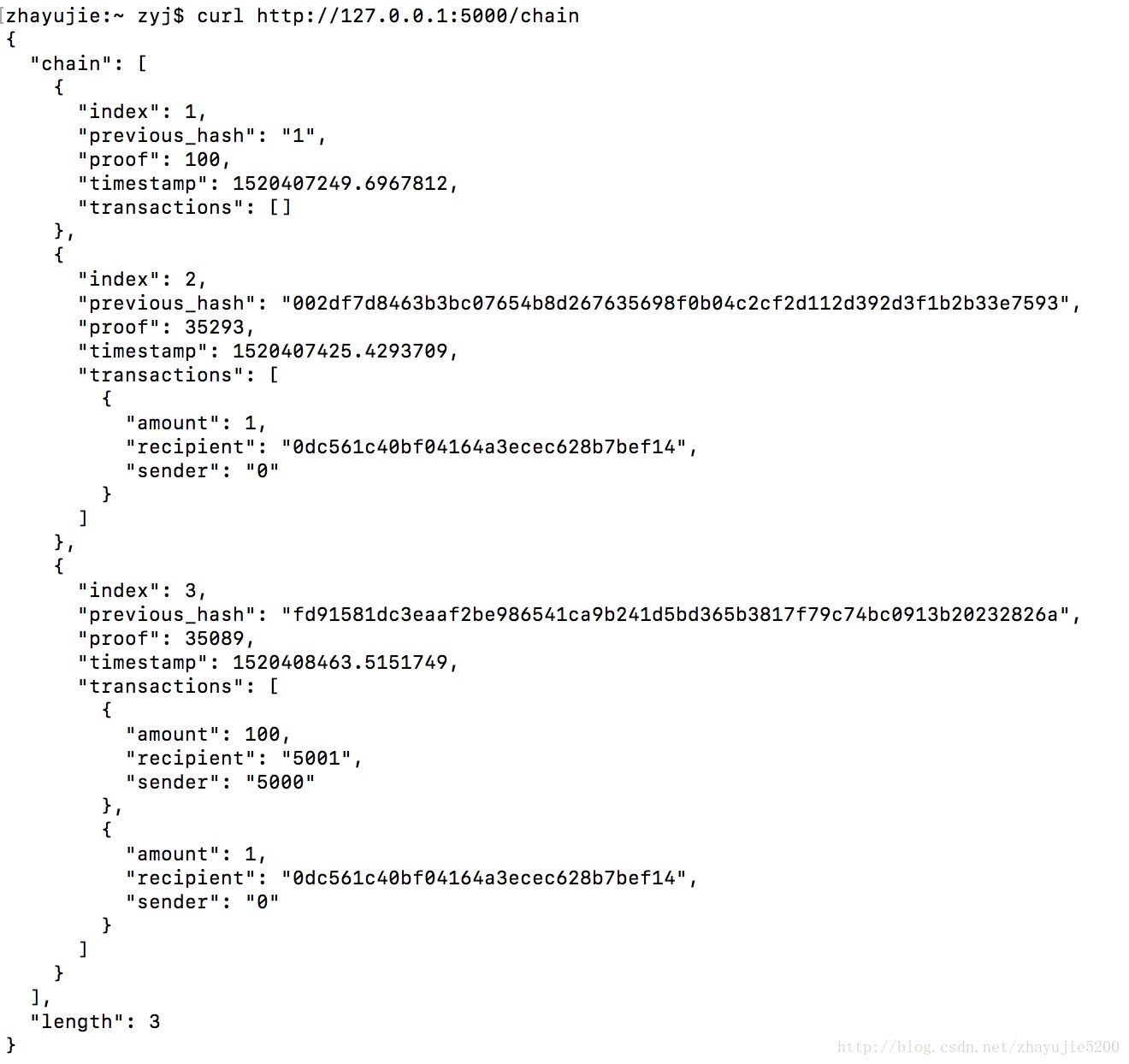Python创建一个简单的区块链
区块链(Blockchain)是一种分布式账本(listributed ledger),它是一种仅供增加(append-only),内容不可变(immutable)的有序(ordered)链式数据结构,该数据结构由网络中的一系列节点共同维护,并且这些节点之间互不信任。区块链是如今盛行的Bitcoin,Ethereum等数字货币背后的底层技术,本文通过Python从0开始创建一个简单的区块链模型,对于理解区块链基本原理很有帮助。
准备
所需条件: python3.6,pip,flask,requests,cURL
flask和requests可通过如下命令下载:
pip install falsk, requests创建文件blockchain.py,所有代码均写在此文件中。
开始
代码主要分为两部分,首先是一个Blockchain类,其中包含区块链的属性和特性方法;然后是相应的路由处理方法,以flask服务器作为区块链网络中的一个节点来处理客户端请求对区块链完成相应操作,以及和网络中其它节点进行交互。
相关数据结构
block:区块,以dict表示,包含属性索引(index),时间戳(timestamp),交易集合(transactions),工作量证明(proof),上一个区块的hash值(previous_hash)。其中,previous_hash用于链接这些有序区块,并且保证其中内容不被更改。
tansaction:交易,dict形式,存放于区块中,包含属性:发出者(sender),接收者(recipient),数额(amount)
Blockchain类的属性
chain:区块链中所有区块的list集合,每个元素都是一个block
current_transactions: 当前即将加入区块的交易集合,list表示
nodes:当前节点的其他相邻节点的set集合
Blockchain类的方法
new_block():生成新的区块,接收工作量证明proof作为参数,将block加入chain中,并且清空当前交易集合,返回生成的block。在
__init__方法中会自动生成一个创世区块(genesis block),初始proof为100,previous_hash为’1’new_transaction():生成新的交易,接收三个参数:发出者,接受者,数额,并将交易加入到当前交易集合中,返回该交易将会加入的区块的索引
hash():生成区块的hash值,接收一个block作为参数,首先利用
json.dumps()将block对象转化为json格式,然后利用hashlib.sha256()计算其hash值proof_of_work():工作量证明算法(PoW),通过循环找一个数p,使得与前一个区块的proof拼接起来的字符串的hash值的前4位为’0000’,接收上一个区块的proof作为参数,返回找到的符合要求的proof
register_node():注册节点,接收一个URL作为参数,利用
urllib.parse.urlparse()解析该地址,获取其中的内容ip:port,并加入到相邻节点集合nodes中resolve_confict(): 共识算法(consensus)解决冲突,即使用网络中最长且有效的链。遍历其他节点的集合
nodes(集合中保存了这些节点的ip和port),利用requests.get()通过路由/chain获取到这些节点的链chain。然后先进行长度判断,如果某节点的链长大于当前节点的链长;则对该链进行有效判断,即遍历该链,判断每个区块的previous_hash和proof值是否满足要求。如果该链更长且有效,则用该chain替换掉自身的链,解决冲突。
URL处理函数
用户提交的数据和服务器的响应数据均使用json格式,服务器利用Flask.request.get_json()获取表单中的json数据,利用Flask.jsonify()将response数据转化为json格式返回。
mine():挖矿,对应路由为
/mine,请求方法为GET。主要完成任务有:计算工作量证明,通过新建交易给予矿工(自身节点)1个币的奖励,新增一个区块并加入链中。new_transaction():新增交易,对应路由为
/transactions/new,请求方法为POST。通过request.get_json()获取用户提交的json格式表单,判断交易是否符合要求,调用类中添加交易的方法。full_chain():查看整条链,对应路由为
/chain,请求方法为GET。register_nodes(): 注册节点,对应路由为
/node/register,方法为POST。接收提交的节点集合,调用register_node()加入这些节点,返回nodes集合consensus():共识,对应路由为
/node/resolve,方法为GET。调用resolve_conflict()解决冲突,返回共识之后的链。
全部代码
import hashlib
import json
from time import time
from uuid import uuid4
from flask import Flask, jsonify, request
from urllib.parse import urlparse
import requests
import sys
class Blockchain(object):
def __init__(self):
# 当前即将加入区块的交易集合
self.current_transactions = []
self.chain = []
self.nodes = set()
# create the genesis block
self.new_block(proof=100, previous_hash='1')
def new_block(self, proof, previous_hash=None):
"""
生成新块
:param proof: <int> The proof given by the PoW algorithm
:param previous_hash: (Optional) <str> hash of Previous block
:return: <dict> new block
"""
block = {
'index': len(self.chain) + 1,
'timestamp': time(),
'transactions': self.current_transactions, # a list
'proof': proof,
'previous_hash': previous_hash or self.hash(self.chain[-1]),
}
# 当前交易集合在加入区块后清空
self.current_transactions = []
self.chain.append(block)
return block
def new_transaction(self, sender, recipient, amount):
"""
生成新的交易信息,将加入下一个待挖的区块中
:param sender: <str> Address of the Sender
:param recipient: <str> Address of the Recipient
:param amount: <int> Amount
:return: <int> The index of the Block that will hold this transaction
"""
self.current_transactions.append({
'sender': sender,
'recipient': recipient,
'amount': amount,
})
return self.last_block['index'] + 1
@property
def last_block(self):
# Return the last block in the chain
return self.chain[-1]
@staticmethod
def hash(block):
"""
生成区块的 SHA-256 hash值
:param block: <dict> Block
:return: <str> the hash value
"""
# we must make sure that the dict is ordered, or we'll have inconsistent hashes
block_string = json.dumps(block, sort_keys=True).encode()
return hashlib.sha256(block_string).hexdigest()
def proof_of_work(self, last_proof):
"""
工作量证明:
- 查找一个 p' 使得 hash(pp')以4个0开头
- p是上一个块的证明, p' 是当前的证明
:param last_proof: <int>
:return: <int>
"""
proof = 0
while self.valid_proof(last_proof, proof) is False:
proof += 1
return proof
@staticmethod
def valid_proof(last_proof, proof):
"""
验证证明:是否hash(last_proof, proof)
:param proof: <int> previous proof
:param last_proof: <int> current proof
:return: <bool> True if correct, Flase if not.
"""
guess_hash = hashlib.sha256((str(last_proof) + str(proof)).encode()).hexdigest()
return guess_hash[:4] == '0000'
def register_node(self, address):
"""
Add a new node to the list of nodes
:param address: <str> Address of node. EG. 'http://192.168.0.5:5000'
:return: None
"""
node = urlparse(address).netloc
self.nodes.add(node)
def valid_chain(self, chain):
"""
Determine if a blockchain is valid
:param chain: <list> a blockchain
:return: <bool> True if valid, False if not
"""
for i in range(1, len(chain)):
block = chain[i]
previous_block = chain[i-1]
if self.hash(previous_block) != block['previous_hash']:
return False
if not self.valid_proof(previous_block['proof'], block['proof']):
return False
return True
def resolve_conflict(self):
"""
共识算法解决冲突,使用网络中最长且有效的链
:param chain: <list> other blockchain
:return: <bool> True 链被取代,False 链未被取代
"""
flag = False
for node in self.nodes:
r = requests.get('http://{}/chain'.format(node))
if r.status_code == 200:
chain = r.json()['chain']
length = r.json()['length']
if length > len(self.chain) and self.valid_chain(chain):
self.chain = chain
flag = True
return flag
# Instantiate our Node
app = Flask(__name__)
# Generate a globally unique address for this Node
node_identifier = str(uuid4()).replace('-', '')
# Instantiate the Blockchain
blockchain = Blockchain()
@app.route('/mine', methods=['GET'])
def mine():
# We run the PoW algorithm to get the next proof...
last_proof = blockchain.last_block['proof']
proof = blockchain.proof_of_work(last_proof)
# 给工作量证明的节点提供奖励,
# 发送者为 '0' 表面是新挖出的币
blockchain.new_transaction(
sender='0',
recipient=node_identifier,
amount=1,
)
block = blockchain.new_block(proof)
response = {
'message': 'New Block Forged',
'index': block['index'],
'transactions': block['transactions'],
'proof': block['proof'],
'previous_hash': block['previous_hash'],
}
return jsonify(response), 200
@app.route('/transactions/new', methods=['POST'])
def new_transaction():
# json.loads(request.get_data())
values = request.get_json()
# Check that the required fields are in POST'ed data
required = ['sender', 'recipient', 'amount']
if not all(k in values for k in required):
return 'Missing values', 400
# Create a new Transaction
index = blockchain.new_transaction(values['sender'], values['recipient'], values['amount'])
response = {'message': 'Transaction will be added to Block {}'.format(index)}
return jsonify(response), 201
@app.route('/chain', methods=['GET'])
def full_chain():
response = {
'chain': blockchain.chain,
'length': len(blockchain.chain),
}
return jsonify(response), 200
@app.route('/node/register', methods=['POST'])
def register_nodes():
values = request.get_json()
nodes = values.get('nodes')
if nodes is None:
return "Error: Please supply a valid list of nodes", 400
for node in nodes:
blockchain.register_node(node)
response = {
'message': 'New nodes have been added',
'total_nodes': list(blockchain.nodes)
}
return jsonify(response), 201
@app.route('/node/resolve', methods=['GET'])
def consensus():
is_replaced = blockchain.resolve_conflict()
if is_replaced:
response = {
'message': 'Our chain was replaced',
'new_chain': blockchain.chain
}
else:
response = {
'message': 'Our chain is authoritative',
'chain': blockchain.chain
}
return jsonify(response), 200
if __name__ == '__main__':
myport = 5000
if len(sys.argv) > 1:
myport = int(sys.argv[1])
app.run(host='0.0.0.0', port=myport)
测试
在一台机器开启多个终端分别运行源代码,通过监听多个不同的端口来模拟多节点网络。这里模拟包含两个节点的区块链网络。
python3 blockchain.py 5000 #在终端1运行
python3 blockchain.py 5001 #在终端2运行挖矿:新建另一个终端3进行通过curl命令进行操作。对节点1进行一次挖矿操作,此时链中有两个区块。
curl http://127.0.0.1:5000/mine发送交易:向节点1发送一个交易。
curl -X POST -H "Content-Type: application/json" -d '{"sender": "5000", "recipient": "5001", "amount": 100}' "http://127.0.0.1:5000/transactions/new"查看区块链:先进行一次mine操作,使刚刚发送的交易进入第3个区块,然后查看整个区块链的数据信息,此时该链有3个区块,其中第3个区块包含两条交易。
curl http://127.0.0.1:5000/mine
curl http://127.0.0.1:5000/chain注册节点:向节点2(端口为5001,1个block)发送节点1的地址(端口为5000,3个block)。
curl -X POST -H "Content-Type: application/json" -d '{"nodes": ["http://127.0.0.1:5000"]}' "http://127.0.0.1:5001/node/register"共识:使节点2完成与相邻节点的共识,用节点1的链(长度为3)替换节点2的链(长度为1)。
curl http://127.0.0.1:5001/node/resolve
参考文章:https://learnblockchain.cn/2017/10/27/build_blockchain_by_python/
Python创建一个简单的区块链的更多相关文章
- 用 Python 构建一个极小的区块链
虽然有些人认为区块链是一个早晚会出现问题的解决方案,但是毫无疑问,这个创新技术是一个计算机技术上的奇迹.那么,究竟什么是区块链呢? 区块链 以比特币(Bitcoin)或其它加密货币按时间顺序公开地记录 ...
- Rust 实现一个简单的区块链
一.背景 近期用 Rust 实现了 Jeiwan/blockchain_go,与原项目相比没有加入新的功能,只是换了一个编程语言实现了一遍,源码放在 Github 上. 开发这个项目,花费了好几个周末 ...
- [Python Study Notes]一个简单的区块链结构(python 2.7)
''''''''''''''''''''''''''''''''''''''''''''''''''''''''''''''''''''''''''''''''''''''''''''''''''' ...
- Python>>>创建一个简单的3D场景
首先安装PyOpengl pip install PyOpenGL PyOpenGL_accelerate
- 基于python创建一个简单的HTTP-WEB服务器
背景 大多数情况下主机资源只有开发和测试相关人员可以登录直接操作,且有些特定情况"答辩.演示.远程"等这些场景下是无法直接登录主机的.web是所有终端用户都可以访问了,解决了人员权 ...
- python创建一个简单的服务
python -m http.server 8000 --bind 0.0.0.0 8000为端口 0.0.0.0允许远程访问
- 用Java实现简单的区块链
用 Java 实现简单的区块链 1. 概述 本文中,我们将学习区块链技术的基本概念.也将根据概念使用 Java 来实现一个基本的应用程序. 进一步,我们将讨论一些先进的概念以及该技术的实际应用. 2. ...
- 通过创建一个简单的骰子游戏来探究 Python
在我的这系列的第一篇文章 中, 我已经讲解如何使用 Python 创建一个简单的.基于文本的骰子游戏.这次,我将展示如何使用 Python 模块 Pygame 来创建一个图形化游戏.它将需要几篇文章才 ...
- 用不到 50 行的 Python 代码构建最小的区块链
引用 译者注:随着比特币的不断发展,它的底层技术区块链也逐步走进公众视野,引起大众注意.本文用不到50行的Python代码构建最小的数据区块链,简单介绍了区块链去中心化的结构与其实现原理. 尽管一些人 ...
随机推荐
- Linux网络服务第一章Linux网络基础设置
1.笔记 systenctl restart network:重启网卡网络服务 bash:刷新主机名称 netstat:查看网络状态 route -n:不做地址解析 mii-tool eno16777 ...
- 【Linux常见命令】tee命令
tee - read from standard input and write to standard output and files tee命令用于读取标准输入的数据,并将其内容输出成文件. t ...
- 如何在 Amazon AWS 上设置一台 Linux 服务器
摘要: AWS(Amazon Web Services)是全球领先的云服务器提供商之一.你可以使用 AWS 平台在一分钟内设置完服务器.在 AWS 上,你可以微调服务器的许多技术细节,如 CPU 数量 ...
- [译] React 16.3(.0-alpha) 新特性
原文地址:What's new in React 16.3(.0-alpha) 原文作者:Bartosz Szczeciński 译文出自:掘金翻译计划 本文永久链接:github.com/xitu/ ...
- Ngxin 开启CDN 日志获取不了真实IP的解决办法。
nginx配置里面在http{ 后加入如下两行代码即可: set_real_ip_from 0.0.0.0/0;real_ip_header X-Forwarded-For; 重启nginx生效. 注 ...
- muduo网络库源码学习————线程类
muduo库里面的线程类是使用基于对象的编程思想,源码目录为muduo/base,如下所示: 线程类头文件: // Use of this source code is governed by a B ...
- ASP.NET Core3.x 基础—注册服务(2)
这篇文章介绍在ASP.NET Core中注册一下自己的服务. 首先创建一个Services文件夹.在文件夹里面创建一个接口 IClock,以及两个类ChinaClock.UtcClock.这两个类分别 ...
- js 箭头函数不适用的场景
箭头函数虽然方便但也不是每个地方都适用, 箭头函数在开发中可以十分方便的干预 this的指向,在一些情况下,是不需要对this的指向进行干预的,也就不适用箭头函数 1.构造函数的原型方法上 例如:Pe ...
- Jetson AGX Xavier/Ubuntu更改pip3源
pip3换源: 修改~/.pip/pip.conf,如果没有这个文件,就创建一个. 内容如下: [global]index-url = https://pypi.tuna.tsinghua.edu.c ...
- HTML往div中赋值
HTML中往div赋值 <div id="mazey">content</div> 使用JavaScript: var mazey=document.get ...





